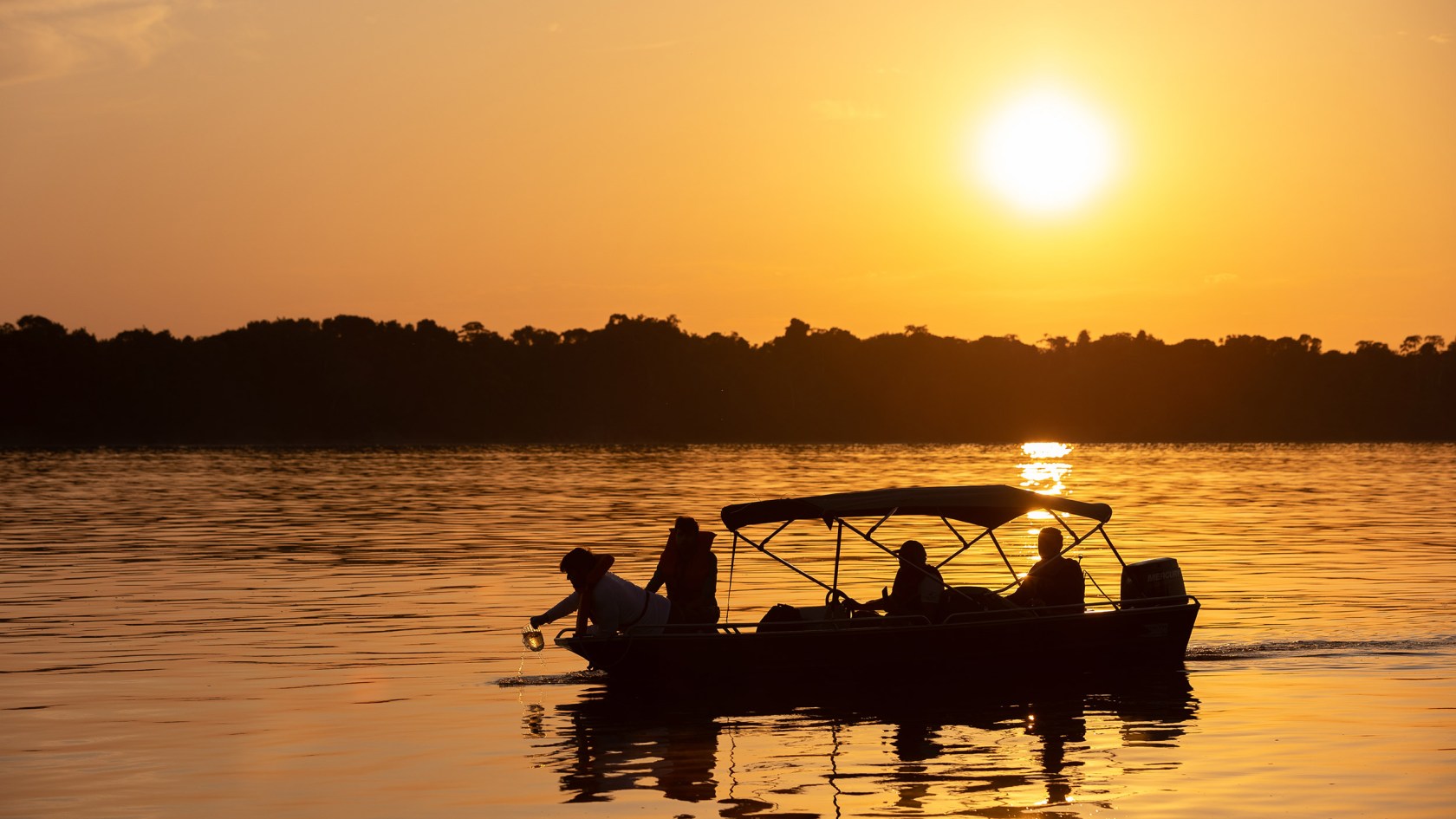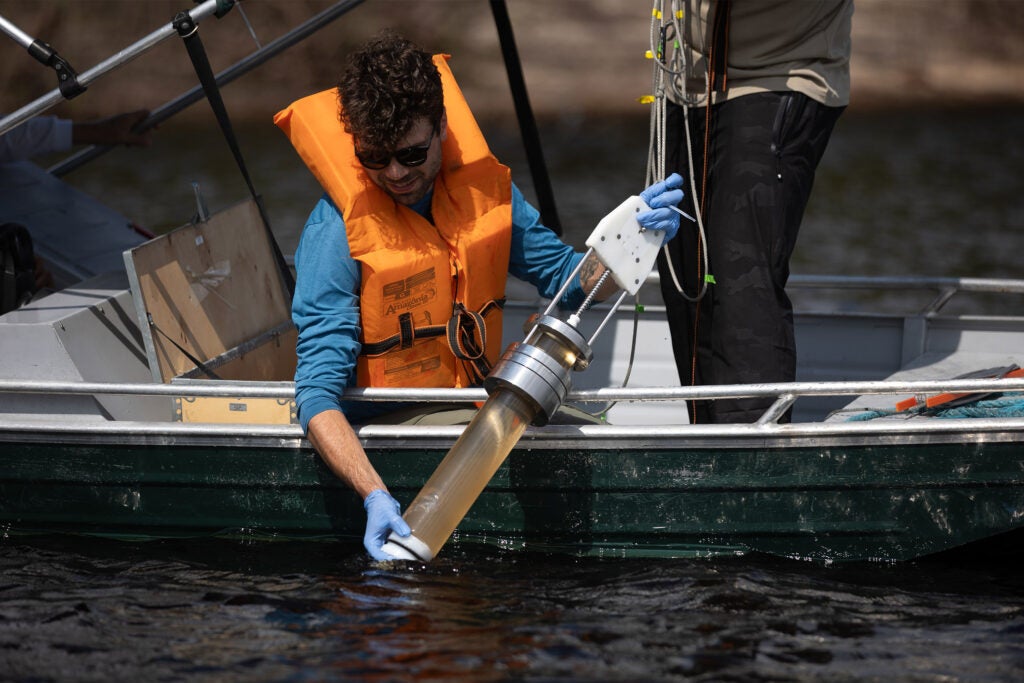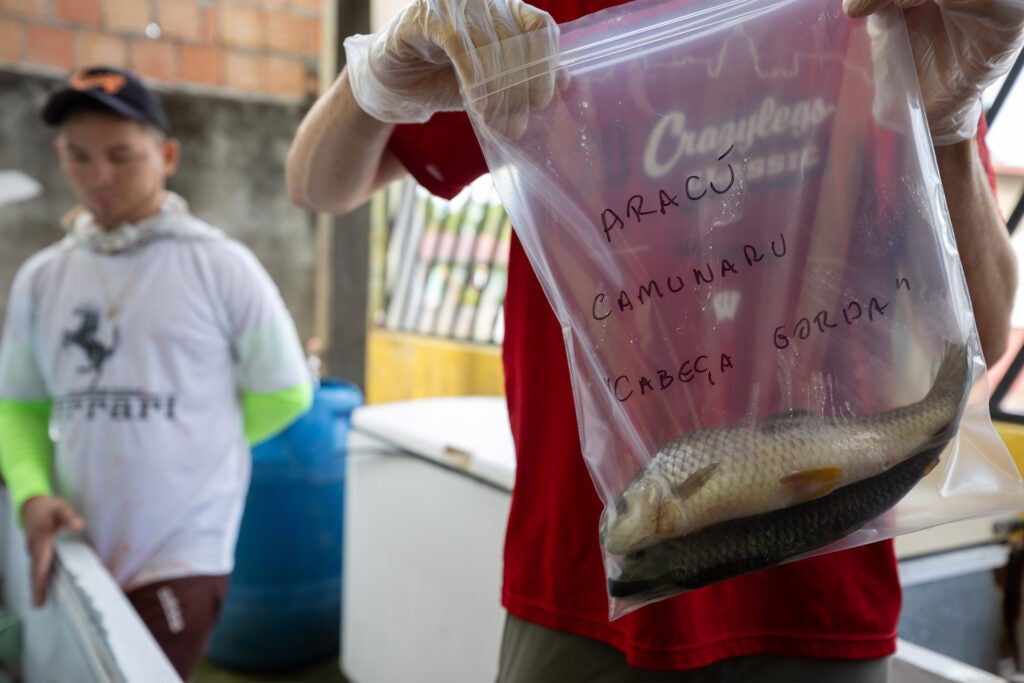
Amazonas State University and Harvard researchers during water collection at dawn on the Rio Negro.
Photos by Bruno Kelly/Ambiental Media
Deep in the Amazon, SEAS team tracks a mobile element
Field work on the Rio Negro could help communities exposed to methylmercury protect their food web
On a hot, humid day in September, Evan Routhier stood on the banks of the Rio Negro in the heart of the Amazon rainforest, chatting with a local fishmonger. Through a translator, Routhier, a graduate student in environmental science and engineering at the Harvard John A. Paulson School of Engineering and Applied Sciences (SEAS), asked the man how concerned he was about mercury contamination in fish.
The man replied that he was worried about fish taken from areas where illegal gold mining took place but other than that, the fish seemed safe.
Since the early 2000s, small-scale, illegal gold mining has exploded along the Amazon and its tributaries. Most of the mining is done by dredging, in which miners pull up sediment along the river and mix it with liquid mercury to separate the gold. The mercury is burned off and turned into vapor, which can end up in the river, soils, and on the leaf canopy above. Mercury contamination, along with high levels of methylmercury, a potent neurotoxin, has been found throughout the Amazon.
“We want to understand how and why mercury is getting transformed into methylmercury and where that mercury is coming from.”
Evan Routhier

“Mercury is very mobile in the environment. This means that some of it travels to non-gold mining areas, and we want to understand if it enters food webs in these regions as well,” Routhier said back in the lab in Cambridge. “The populations along the river eat fish most meals a day, so making sure the fish are healthy to eat is important for local communities.”
“Multiple past studies have shown high mercury concentrations in the hair of Indigenous peoples in the Amazon basin, illustrating the strong adverse effects of gold-mining activities in what is seemingly a relatively pristine part of the planet, at least from a far-away viewpoint like an overhead passing passenger aircraft,” said Scot Martin, Gordon McKay Professor of Environmental Science and Engineering and Professor of Earth and Planetary Sciences.
Routhier and his teammate Faiz Haque, a research fellow at SEAS, are part of a project led by Martin and Elsie Sunderland, Fred Kavli Professor of Environmental Chemistry and Professor of Earth and Planetary Sciences, to understand how mercury enters the food web and bioaccumulates in food webs in the rivers of the Amazon rainforest. The Harvard team is working closely with the teams of Sergio Duvoisin Junior and Rodrigo Souza, professors at Amazonas State University (UEA) in Brazil.
The project is funded by the Amazonas State Research Support Foundation, the Amazonas Environmental Protection Institute, and the State Secretariat for the Environment.
“All of this work was enabled by the terrific collaboration with the UEA team, and it would have been impossible without them,” said Martin, who has also collaborated with UEA on research measuring volatile organic compounds in the Amazon. “Working with the UEA team was synergistic both for focusing the research activities and for sampling in the Amazonian context, not to mention the essential logistical contributions of the UEA research boat.”
This fall, Routhier and Haque joined UEA researchers on their research vessel for a two-week voyage up and down the Rio Negro to collect water, sediment, soil, and fish samples. While the Harvard team was focused on mercury and methylmercury, the UEA researchers also collected samples to test the general water quality of the area. The mission was named the OXIOUUWI Campaign, which means black in the Indigenous Yanomami language.
On the river
Because of El Niño, the season was especially hot and dry, with several days exceeding 100 degrees. The boat moved slowly to navigate through a shallower river, carefully skirting sandbars and beached boats.
Several times a day, Routhier and Haque would head out in a dinghy to collect water and sediment samples from the river, dipping their instruments into the dark waters of the Rio Negro. The team hiked into the jungle to collect soil samples and every couple of days stopped at a town or village — some as large as 15,000 people, others only about 1,000 — to buy fish from local markets.

Back onboard the boat, Routhier and Haque set up a simple lab space to process and preserve the samples for their long flight back to Cambridge. On campus, the team will analyze the samples for total mercury and methylmercury concentration, mercury isotopes, and carbon levels, which can influence mercury methylation in the water.
“We want to understand how and why mercury is getting transformed into methylmercury and where that mercury is coming from,” said Routhier. “If you start with a source from local gold mining, it’s going to have a very distinct isotopic signature from mercury that came from the global pool, was deposited on the forest canopy through the atmosphere, transported into the water through soils and then finally into the water, where it gets methylated. So a lot of what we’re doing is forensics, figuring out where the mercury is coming from and what processes it’s undergone in the environment.”
The research could lead to a better understanding of the mercury cycle in the southern hemisphere, which isn’t well understood. Much of what is known about methylmercury accumulation in the northern hemisphere comes from research done in lakes and streams, which have different chemistries than large southern hemisphere tropical rivers like the Rio Negro.
“These communities, which rely on the forest and the river for their food and livelihood, are really tuned in to what’s happening from climate change in a very real way.”
Evan Routhier
But no matter how well Routhier, Haque, or the rest of the team study the river, they’ll never know it quite as well as the people who have lived on it for generations.
“I was amazed by how much knowledge these people had about the river and the surrounding forest from observation,” said Routhier. “It was scientific knowledge, from observations of water levels and how the forest has been changing. These communities, which rely on the forest and the river for their food and livelihood, are really tuned in to what’s happening from climate change in a very real way.”
The team is planning another research trip this spring on the Madeira River, which has different water chemistry than the Rio Negro and is further impacted by anthropogenic development. There are also hopes to return to the Rio Negro in the wet season to travel farther up the river and collect more samples.





